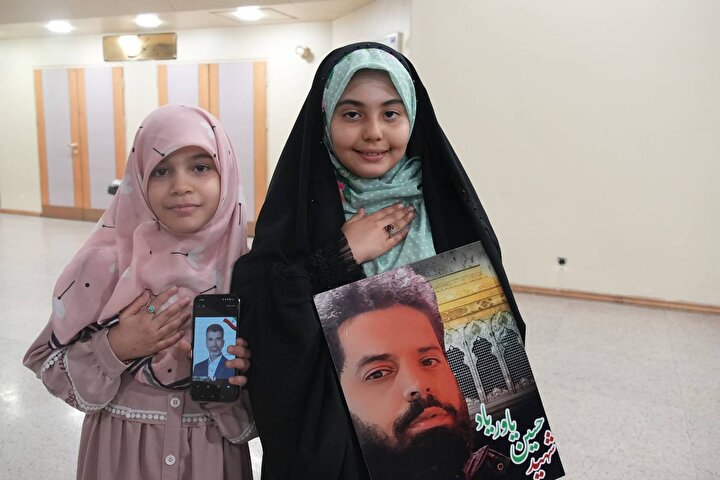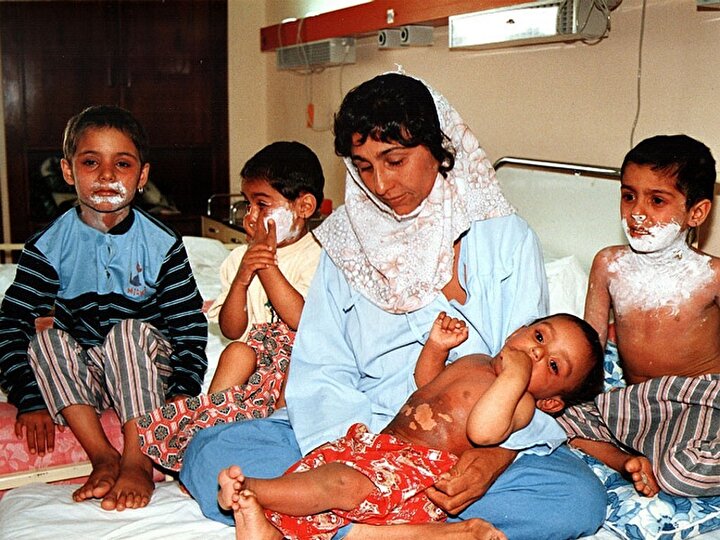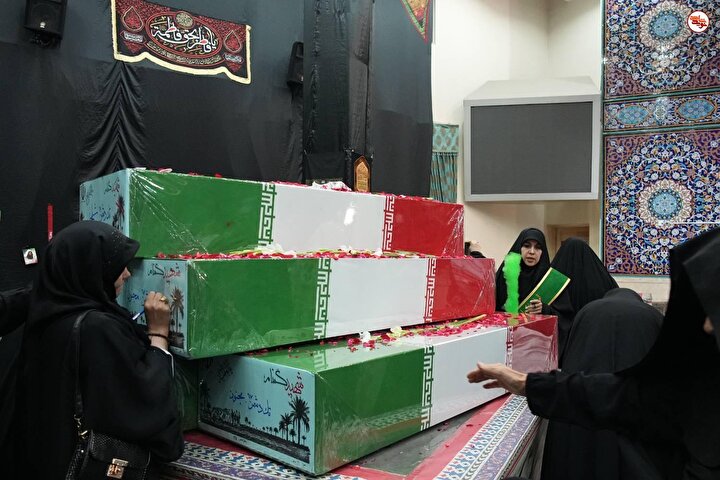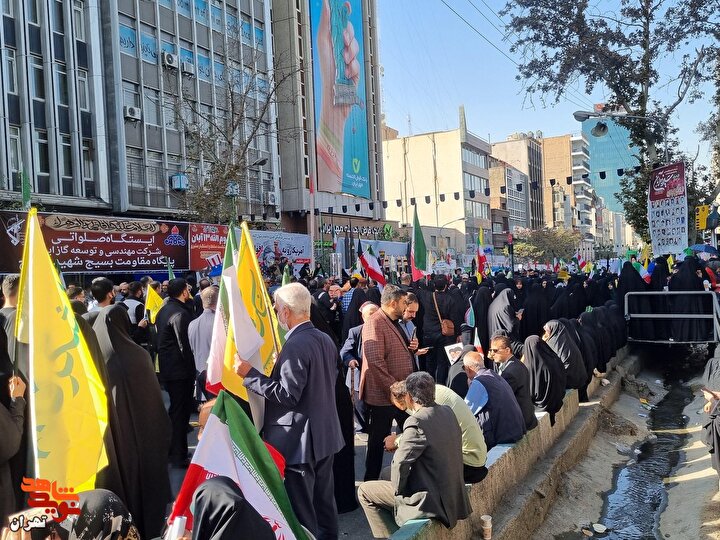By Shahed Publications, titled "A Descendant of the Men of Ashura":
Shahed Yaran Monthly on Martyr Abshenasan Published
Navideshahed: ‘A Man from the Family of Ashuraei Group’ is the subject of the 83rd volume of Shahed Yaran Magazine which has been released by the Foundation of Martyrs and Veterans Affairs under the chief secretary of Masoud Zaribafan in September 2012. The price of the magazine is 1600 Tomans.

The titles in this issue include the preamble of the statement of supreme leader in visiting the martyrs families of Kurdistan on May 15, 2009, martyr Abshanasan from birthday to martyrdom time based on the outlook of Hassan Khameh Yar, The speeches of martyr major general Hassan Abshanasan during the memorial ceremony of martyr Commander Mohammad Brojerdi, a description of Ghader military operation, bibliopoly of martyr Hassan Abshanasan have been released.
In a section of this magazine it has been mentioned: “Martyr Abshanasan stated a narration regarding the chief of the faithful Ali (AS) for the current and future generations: “On the day that humans are supposed to die, if that person to live in the deepest part of the seas or over the clouds, eventually that persons will die on the day that he/she must pass away and if a moment of the lifetime has been remained, if the humans to be fallen inside the burning fires or to be sent inside the deep whirlpools, he/she won’t die at all.”?
In this magazine an interview had been done with Amir Naser Arasteh, the deputy of the military Advisors Group of the supreme leader and the head of the War Knowledge Committee of martyr Sayad Shirazi with the subject ‘An analysis in the knowledge and belief positions of martyr Hassan Abshanasan’, with commander Esmael Ahmadi Moghadam, the commander of the general armed forces of the Islamic Republic of Iran, with the devotee brigadier general Ahmad Dadbin, the former commander of the Islamic Republic of Iran’s Ground Force regarding a glance to the mystical features of martyr Hassan Abshanasan, Giti Zendeh Nam as the spouse of martyr major general Hassan Abshanasan, with the retired brigadier general ‘Masoud Bakhtiyari’ with the subject of reviewing the features of martyr Hassan Abshanasan, with commander brigadier general Siyavash Jawadiyan as the former deputy of the AJA Joint Staff Headquarters regarding the review of the events of northwest of Iran, with colonel Ali Moradi as the chief of the office of supreme leader advisors titled ‘reviewing the mental and intellectual phases of evolution of martyr Hassan Abshanasan, with devotee Amir Ahmad Asadi as one of the comrades of that martyr with the subject of some untold things regarding the Jihadist and operative fighting of martyr Hassan Abshanasan.
In a section of the interview with commander Naser Arasteh, the deputy of the military advisors for the supreme leader and the chief of the war knowledge committee of martyr Sayad Shirazi has been stated: “Martyr Abshanasan had many features and characteristics in a way that maybe we can’t count them. In the military field, he was a very educated officer. In the field of passing different military courses, he was a skillful officer. At that time they had nicknamed him as ‘The Lion of Desert’ and some would also call him as ‘The Old man of the desert’, but in my opinion both interpretations are accurate. He accomplished different military trainings including commando, ranger, paratrooper and anti-guerrilla by getting excellent grades. He had a very strong and sporty body. He had very sharp eyes. He would always try to predict the future and to think about the future issues. In addition to these military features, I could see the firmness and greatness from the strong body of martyr Abshanasan. When at one night I observed him as he was bowing down, I noticed that he was crying in tears and he was worshipping God so honestly. I could not accept that by this behavior he could be so firm in the battlefields. Someday he had held the Kalashnikov gun and he would climb the mountains in a way that the young people could not do that; in fact no one could believe that martyr Abshanasan had that kind of compassionate and spiritual heart that he would cry in tears when he was prostrating in front of God.”?
Also reviewing the management role of martyr Hassan Abshanasan in interview with brigadier general of the Airborne ‘Shahram Ramtin, the former supervisor of the Army 28 of Kurdistan, a review on the characteristics of martyr Abshanasan in an interview with the brigadier general Farhad Behroozi, the former commander of the Army 23 of Special Forces, the unsaid things of resistance and Jihad stages of martyr Hassan Abshanasan in an interview with commander brigadier general Hassan Rastegar Panah, the manager of Comprehensive University of Imam Ali (AS), reviewing the features of martyr Hassan Abshanasan in and interview with the devotee prisoner of war ‘colonel Mojtaba Jafari’, the head of the Islamic Republic of Iran’s Army war veterans, reviewing the memories of resistance and victory days in an interview with Basiji Hji Amir Nikdel as one of the comrades of martyr Hassan Abshanasan are the interesting interviews of this version of Shahed Yaran magazine.
Some unpublished photos of martyr Hassan Abshanasan in the armored Army of Ahvaz dating back to 1964, in the uniform of a major in 1975, at the time of praying, in the armored brigade 65 of Dezful, at the time of issuing Ghader military operation in north Iraq, showing his arts during one of his operations on a thread, near martyr Sayad Shirazi at the time of cleanup of Baneh- Sardasht strip in 1982, in the war zone ‘Dasht Abbas’, near martyr Mahmoud Kaveh, martyr Ghomi and Seyed Mehdi Hashemi, the member of Islamic Parliament, martyr Abshanasan and martyr Mahmoud Kaveh from the commanders of the brigade ‘Shohada’, commander Ahmad Asadi having a case in his hand at the time of receiving demands from martyr Sayad Shirazi, the hot topic of Kurdistan’s cleanup between martyr Abshanasan and commander Ahmad Asadi, martyr Abshanasan and martyr Ganji Zadeh from the commanders of the brigade ‘Shohada’ in the northern battled, martyr Abshanasan near Seyed Habib as the grandchildren of Imam Jafar Sadegh (AS), martyr Abshanasan near Hassan Khorami, martyr Brojerdi and martyr Mahmoud Kaveh, the role of the war zone of Ghader military operation inside the Iraqi territories and many other relevant photos have been released.
In the bibliography section of martyr Abshanasan, in addition of introducing the books regarding this martyr, it has been mentioned: “Until now many precious books and works have been released regarding this respectful martyr in order to keep his name and memory alive by the writers and historians and cultural institutes of the Islamic Republic including the Army Political and Ideology Organization. IN these works the details of the biography of this respectful martyr which is full of Gnosticism, religious affairs, Jihad and permanent resistance of this respectful martyr in different stages of life that eventually he was nicknamed as ‘The lion of Desert’ and ‘The old man of the desert’.”?
This section introduces the most important works including:
1. The valuable book ‘The lion of Desert’ which is related to the biography of martyr Hassan Abshanasan which has been compiled by the retired colonel ‘Alireza Pour’ known as Vafi and it has submitted it to the Islamic Revolution Documentation Center in 101 pages in 2003.
2. The book ‘the Half hidden part of moon’ which narrates the biography and memories of martyr Hassan Abshanasan based on the narration of his spouse ‘Giti Zendeh Nam’. The book was compiled by the efforts of Marjan Fooladvand and it was released in 2007 by Fath Narration Publication in 77 pages.
3. The book ‘The Men of the Light Land’ which his a collection of the memories of strong commanders of the ground force including martyr Hassan Abshanasan, martyr Hassan Agharab Parast, martyr Masoud Monfared Niyaki and on and on.
4. The book ‘Lighter than blue’ which is the biography story which shows the fighting and martyrdom of Colonel Hassan Abshanasan. This book has been compiled and authored in 11 chapters and 160 pages by the cooperation of Farzam Zhirzadi and it was released in 2002 by Shahed Publication…
5. The book ‘The falcon of mountains’ is a story related martyr Hassan Abshanasan which has been released by the effort of Golestan Jafariyan and by collaboration of Army Political Ideology Publication in the field of introducing this respectful martyr in 2008.
It should be noted that martyr Hassan Abshanasan was the commander of Hamzeh Seyed Al-Shohada (AS) Headquarters and the commander of the Army 23 of Airborne for the Special Forces the same as other outstanding martyrs of the eight year war of Sacred Defense Era and Kurdistan conflicts, he played a very valuable role in fighting against the global arrogance and the liberation of Islamic country. Martyr Hassan Abshanasan, the commander of northwest of Iran (Hamzeh Seyed Al-Shohda (AS)) and the commander of the Army 23 of Nohed (Islamic Republic of Iran’s Army) was born in 1936 in a religious and pious family in Tehran city. He spent his childhood by education in the schools and he was able to get the diploma in 1957 and then he joined the Military college. In 1960 he graduated from the collage with the degree of Second Lieutenant rank and he accomplished the elementary courses after a year.
After that in the first military training of ranger, the excellent training courses of commandership, the parachute and ranger courses inside and outside of Iran and he accomplished all of these courses and trainings successfully. Despite of the unreasonable condition of the country, he succeeded to pass the steps of development and growth. After the victory of Islamic Revolution, his ranking was promoted to Colonel and he was appointed as the commander of Irregular Wars Unit in the Headquarters of Seyed Al-Shohda (AS) for the Army.
Martyr Abshanasan trained the new forces in Saad Abad Training center when the Islamic Revolutionary Guard Corps was created and in 1984 based on the official demand of Ramadan Headquarter and when they provided the environment of irregular war trainings for the Islamic Revolutionary guard corps, this responsibility was given to him. When he accepted this responsibility, he trained the guerilla war tactics to the forces of the Islamic Revolutionary guard corps, Basijis and his comrades and he educated many students in this field and all of them created many sacrifices in the battlefields so beautifully. At the beginning of the Imposed War Era, the soil of the southern battlefields got familiar with his firmness and strength. But he behaved like a simple Basiji in taking part in the military operations which took place in Piranshahr, Sardasht and Baneh and he performed many sacrifices. In fact he made this land and the hearts of the Iranian nation and history to remember his courage and sacrifices. He was one of the close comrades and friends of martyr Mohammad Brojerdi too. When he was the commander of the Army 26 of Nohed, he had the commandership of the Hamzeh Headquarters and the Army 33 of the Special Forces. He was martyred in 1985 during the Ghader military operation which took place in Loland war zone. During this operation a quiver hit him and he drank the sweet drink of martyrdom and he perfumed the sky of the battlefields with the symbol of stability in the school of Islam, revolution and Imam Khomeini.
The End
The titles in this issue include the preamble of the statement of supreme leader in visiting the martyrs families of Kurdistan on May 15, 2009, martyr Abshanasan from birthday to martyrdom time based on the outlook of Hassan Khameh Yar, The speeches of martyr major general Hassan Abshanasan during the memorial ceremony of martyr Commander Mohammad Brojerdi, a description of Ghader military operation, bibliopoly of martyr Hassan Abshanasan have been released. In a section of this magazine it has been mentioned: “Martyr Abshanasan stated a narration regarding the chief of the faithful Ali (AS) for the current and future generations: “On the day that humans are supposed to die, if that person to live in the deepest part of the seas or over the clouds, eventually that persons will die on the day that he/she must pass away and if a moment of the lifetime has been remained, if the humans to be fallen inside the burning fires or to be sent inside the deep whirlpools, he/she won’t die at all.”? In this magazine an interview had been done with Amir Naser Arasteh, the deputy of the military Advisors Group of the supreme leader and the head of the War Knowledge Committee of martyr Sayad Shirazi with the subject ‘An analysis in the knowledge and belief positions of martyr Hassan Abshanasan’, with commander Esmael Ahmadi Moghadam, the commander of the general armed forces of the Islamic Republic of Iran, with the devotee brigadier general Ahmad Dadbin, the former commander of the Islamic Republic of Iran’s Ground Force regarding a glance to the mystical features of martyr Hassan Abshanasan, Giti Zendeh Nam as the spouse of martyr major general Hassan Abshanasan, with the retired brigadier general ‘Masoud Bakhtiyari’ with the subject of reviewing the features of martyr Hassan Abshanasan, with commander brigadier general Siyavash Jawadiyan as the former deputy of the AJA Joint Staff Headquarters regarding the review of the events of northwest of Iran, with colonel Ali Moradi as the chief of the office of supreme leader advisors titled ‘reviewing the mental and intellectual phases of evolution of martyr Hassan Abshanasan, with devotee Amir Ahmad Asadi as one of the comrades of that martyr with the subject of some untold things regarding the Jihadist and operative fighting of martyr Hassan Abshanasan. In a section of the interview with commander Naser Arasteh, the deputy of the military advisors for the supreme leader and the chief of the war knowledge committee of martyr Sayad Shirazi has been stated: “Martyr Abshanasan had many features and characteristics in a way that maybe we can’t count them. In the military field, he was a very educated officer. In the field of passing different military courses, he was a skillful officer. At that time they had nicknamed him as ‘The Lion of Desert’ and some would also call him as ‘The Old man of the desert’, but in my opinion both interpretations are accurate. He accomplished different military trainings including commando, ranger, paratrooper and anti-guerrilla by getting excellent grades. He had a very strong and sporty body. He had very sharp eyes. He would always try to predict the future and to think about the future issues. In addition to these military features, I could see the firmness and greatness from the strong body of martyr Abshanasan. When at one night I observed him as he was bowing down, I noticed that he was crying in tears and he was worshipping God so honestly. I could not accept that by this behavior he could be so firm in the battlefields. Someday he had held the Kalashnikov gun and he would climb the mountains in a way that the young people could not do that; in fact no one could believe that martyr Abshanasan had that kind of compassionate and spiritual heart that he would cry in tears when he was prostrating in front of God.”? Also reviewing the management role of martyr Hassan Abshanasan in interview with brigadier general of the Airborne ‘Shahram Ramtin, the former supervisor of the Army 28 of Kurdistan, a review on the characteristics of martyr Abshanasan in an interview with the brigadier general Farhad Behroozi, the former commander of the Army 23 of Special Forces, the unsaid things of resistance and Jihad stages of martyr Hassan Abshanasan in an interview with commander brigadier general Hassan Rastegar Panah, the manager of Comprehensive University of Imam Ali (AS), reviewing the features of martyr Hassan Abshanasan in and interview with the devotee prisoner of war ‘colonel Mojtaba Jafari’, the head of the Islamic Republic of Iran’s Army war veterans, reviewing the memories of resistance and victory days in an interview with Basiji Hji Amir Nikdel as one of the comrades of martyr Hassan Abshanasan are the interesting interviews of this version of Shahed Yaran magazine. Some unpublished photos of martyr Hassan Abshanasan in the armored Army of Ahvaz dating back to 1964, in the uniform of a major in 1975, at the time of praying, in the armored brigade 65 of Dezful, at the time of issuing Ghader military operation in north Iraq, showing his arts during one of his operations on a thread, near martyr Sayad Shirazi at the time of cleanup of Baneh- Sardasht strip in 1982, in the war zone ‘Dasht Abbas’, near martyr Mahmoud Kaveh, martyr Ghomi and Seyed Mehdi Hashemi, the member of Islamic Parliament, martyr Abshanasan and martyr Mahmoud Kaveh from the commanders of the brigade ‘Shohada’, commander Ahmad Asadi having a case in his hand at the time of receiving demands from martyr Sayad Shirazi, the hot topic of Kurdistan’s cleanup between martyr Abshanasan and commander Ahmad Asadi, martyr Abshanasan and martyr Ganji Zadeh from the commanders of the brigade ‘Shohada’ in the northern battled, martyr Abshanasan near Seyed Habib as the grandchildren of Imam Jafar Sadegh (AS), martyr Abshanasan near Hassan Khorami, martyr Brojerdi and martyr Mahmoud Kaveh, the role of the war zone of Ghader military operation inside the Iraqi territories and many other relevant photos have been released. In the bibliography section of martyr Abshanasan, in addition of introducing the books regarding this martyr, it has been mentioned: “Until now many precious books and works have been released regarding this respectful martyr in order to keep his name and memory alive by the writers and historians and cultural institutes of the Islamic Republic including the Army Political and Ideology Organization. IN these works the details of the biography of this respectful martyr which is full of Gnosticism, religious affairs, Jihad and permanent resistance of this respectful martyr in different stages of life that eventually he was nicknamed as ‘The lion of Desert’ and ‘The old man of the desert’.”? This section introduces the most important works including: 1. The valuable book ‘The lion of Desert’ which is related to the biography of martyr Hassan Abshanasan which has been compiled by the retired colonel ‘Alireza Pour’ known as Vafi and it has submitted it to the Islamic Revolution Documentation Center in 101 pages in 2003. 2. The book ‘the Half hidden part of moon’ which narrates the biography and memories of martyr Hassan Abshanasan based on the narration of his spouse ‘Giti Zendeh Nam’. The book was compiled by the efforts of Marjan Fooladvand and it was released in 2007 by Fath Narration Publication in 77 pages. 3. The book ‘The Men of the Light Land’ which his a collection of the memories of strong commanders of the ground force including martyr Hassan Abshanasan, martyr Hassan Agharab Parast, martyr Masoud Monfared Niyaki and on and on. 4. The book ‘Lighter than blue’ which is the biography story which shows the fighting and martyrdom of Colonel Hassan Abshanasan. This book has been compiled and authored in 11 chapters and 160 pages by the cooperation of Farzam Zhirzadi and it was released in 2002 by Shahed Publication… 5. The book ‘The falcon of mountains’ is a story related martyr Hassan Abshanasan which has been released by the effort of Golestan Jafariyan and by collaboration of Army Political Ideology Publication in the field of introducing this respectful martyr in 2008. It should be noted that martyr Hassan Abshanasan was the commander of Hamzeh Seyed Al-Shohada (AS) Headquarters and the commander of the Army 23 of Airborne for the Special Forces the same as other outstanding martyrs of the eight year war of Sacred Defense Era and Kurdistan conflicts, he played a very valuable role in fighting against the global arrogance and the liberation of Islamic country. Martyr Hassan Abshanasan, the commander of northwest of Iran (Hamzeh Seyed Al-Shohda (AS)) and the commander of the Army 23 of Nohed (Islamic Republic of Iran’s Army) was born in 1936 in a religious and pious family in Tehran city. He spent his childhood by education in the schools and he was able to get the diploma in 1957 and then he joined the Military college. In 1960 he graduated from the collage with the degree of Second Lieutenant rank and he accomplished the elementary courses after a year. After that in the first military training of ranger, the excellent training courses of commandership, the parachute and ranger courses inside and outside of Iran and he accomplished all of these courses and trainings successfully. Despite of the unreasonable condition of the country, he succeeded to pass the steps of development and growth. After the victory of Islamic Revolution, his ranking was promoted to Colonel and he was appointed as the commander of Irregular Wars Unit in the Headquarters of Seyed Al-Shohda (AS) for the Army. Martyr Abshanasan trained the new forces in Saad Abad Training center when the Islamic Revolutionary Guard Corps was created and in 1984 based on the official demand of Ramadan Headquarter and when they provided the environment of irregular war trainings for the Islamic Revolutionary guard corps, this responsibility was given to him. When he accepted this responsibility, he trained the guerilla war tactics to the forces of the Islamic Revolutionary guard corps, Basijis and his comrades and he educated many students in this field and all of them created many sacrifices in the battlefields so beautifully. At the beginning of the Imposed War Era, the soil of the southern battlefields got familiar with his firmness and strength. But he behaved like a simple Basiji in taking part in the military operations which took place in Piranshahr, Sardasht and Baneh and he performed many sacrifices. In fact he made this land and the hearts of the Iranian nation and history to remember his courage and sacrifices. He was one of the close comrades and friends of martyr Mohammad Brojerdi too. When he was the commander of the Army 26 of Nohed, he had the commandership of the Hamzeh Headquarters and the Army 33 of the Special Forces. He was martyred in 1985 during the Ghader military operation which took place in Loland war zone. During this operation a quiver hit him and he drank the sweet drink of martyrdom and he perfumed the sky of the battlefields with the symbol of stability in the school of Islam, revolution and Imam Khomeini. The End




